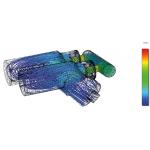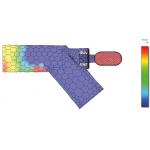Latest News
December 1, 2006
By Stephen Ferguson
Like most engineers, VIASYS Healthcare pneumatic specialist Steve Han was accustomed to the hard slog that traditionally accompanies the design of a new product. He welcomed the company’s purchase of STAR-Works to avoid the weeks and even months it typically took to make small improvements to its products, but he stunned company managers when he delivered a revolutionary new ventilator device design just a few days after the software was installed. With guidance from Steve Duquette, VIASYS director of research and development, Han eliminated almost a year’s worth of design, test, and redesign, saving hundreds of thousands of dollars in development costs alone.
Han and his colleagues were working on the redesign of an infant continuous positive airway pressure (CPAP) ventilator device to treat apnea. The condition is an involuntary temporary interruption in breathing, which can prove terribly damaging or fatal in newborns.

The STAR-Works simulation on the left shows the flow path through a redesigned infant CPAP ventilation unit. On the right is a pressure distribution analysis of the system. Images courtesy VIASYS Healthcare.
The CPAP machine works by delivering a constant stream of compressed air via a mask that acts to splint the patient’s airway, preventing obstruction and allowing the patient to breathe freely. Maintaining a constant pressure that differs for each patient is critical; if the pressure is too high then it opposes the patient’s natural exhalation and increases the work of breathing.
Han’s analysis concentrated on the redesign of the jet-venturi, the critical component in regulating pressure. The opening measures just 0.04 inch, making physical testing of prototypes very difficult due to the tight manufacturing tolerances and the possibility that small defects could significantly influence test results.
Using CD-adapco’s STAR-Works, the VIASYS team rapidly evaluated multiple design changes from their desktop computers, all within the SolidWorks environment. Because the CFD functionality is accessible through additional menus in the SolidWorks GUI, the team started using STAR-Works analysis within hours of installation.
| Image courtesy VIASYS. |
> > A close up of the redesigned infant ventilation mask.
Part of the reason for the speedy analysis is that the STAR-Works CFD results are fully associative with the CAD geometry and are stored as part of the model. This means details are easily accessible to downstream users, even after several years. After any modification in the CAD model, the simulation results can be updated almost instantly by clicking the “update solution” button.
“It was difficult to believe at first,” says Han, “almost every design change resulted in a significant improvement. Incredibly, within three days we had reduced the supply pressure required to the unit by 48 percent.”
| Image courtesy VIASYS. |
< < The infant continuous positive airway pressure—CPAP—ventilator device.
The pressure reduction the CPAP unit means the device can be used with the majority of VIASYS ventilators, rather than two critical care ventilators that had previously been the case. It is also 30 percent more efficient than previous versions, making it more cost effective and possibly a big seller among VIASYS Healthcare’s customers, which include hospitals, alternate care sites, clinical laboratories, and private physicians in more than 100 countries.
A physical prototype confirmed the improvements predicted by the CFD analysis. “We were pretty amazed,” says Han, “the results of the first prototype were within a few percent of those predicted by STAR-Works. Within three days STAR-Works had paid for itself!”
At the time of writing, the new ventilator device is undergoing clinical patient testing and is expected to be on the market shortly. Steve is currently using STAR-Works Gateway and STAR-CCM+ to tackle problems with more complex physics.
Stephen Ferguson is a senior consultant engineer with CD-adapco in London. Prior to joining CD-adapco, Stephen worked for a major automotive company and for Europe’s largest engineering consultancy. He is currently CD-adapco’s sector manager for the building services and biomedical industries. Stephen received an MSc in computational fluid dynamics from Imperial College London in 1998. Send your comments about this article through e-mail by clicking here. Please reference “VIASYS, December 2006” in your message.
Contact Information
CD-adapco
London, UK
SolidWorks Corp.
Concord, MA
VIASYS Healthcare, Inc.
Conshohocken, PA
Subscribe to our FREE magazine, FREE email newsletters or both!
Latest News
About the Author
DE’s editors contribute news and new product announcements to Digital Engineering.
Press releases may be sent to them via [email protected].






